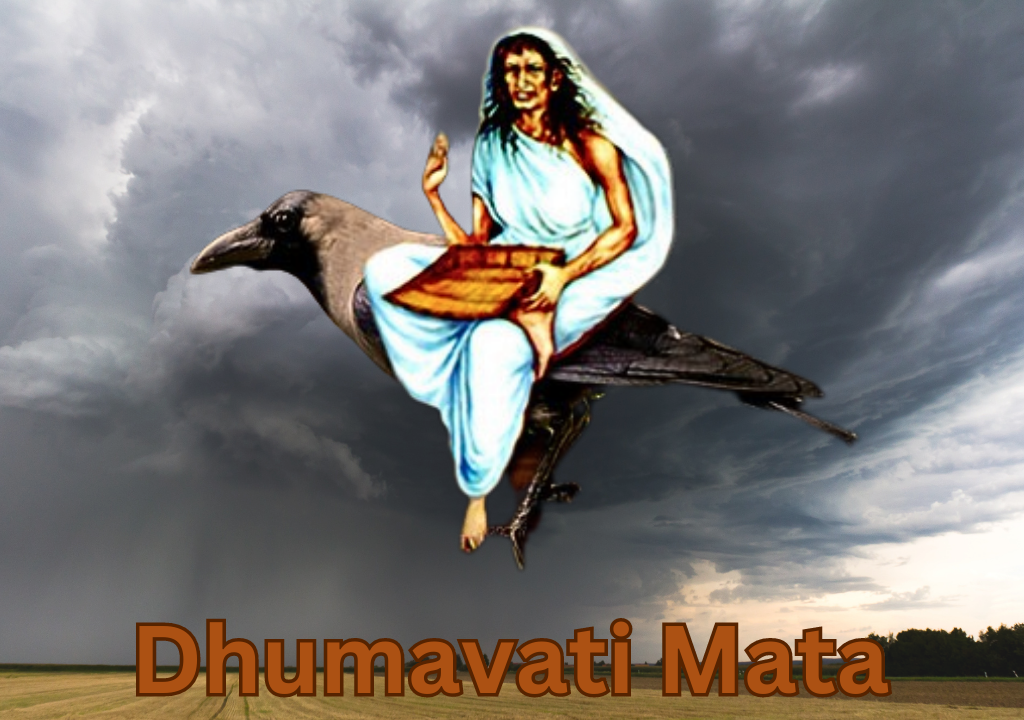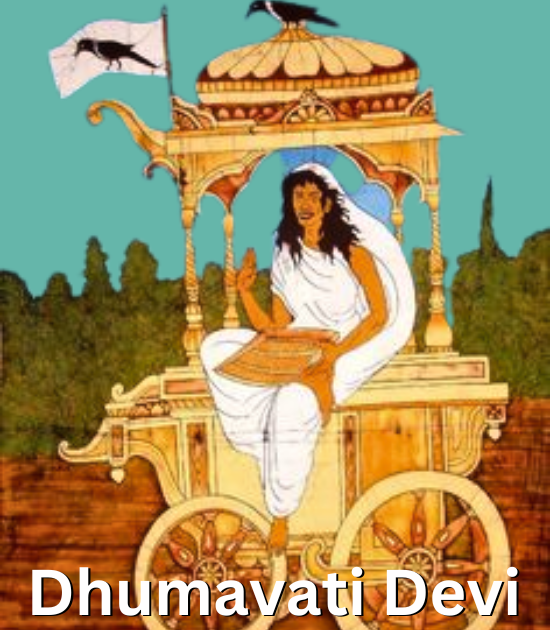Dhumavati is one of the ten Mahavidya goddesses and is often considered to be the seventh in the sequence. She is typically depicted as an old widow and is associated with things that are generally considered inauspicious or unappealing. According to tradition, she is known for her association with death, decay, and chaos.
Despite her fierce appearance and association with negative qualities, Dhumavati is still revered as a powerful goddess in Hindu tradition. She is believed to grant her devotees wisdom, detachment, and liberation from worldly desires, making her an important figure in the pursuit of spiritual growth and enlightenment. Her unique qualities and symbolism have made her a popular object of devotion for those seeking to transcend the material world and attain a deeper understanding of the nature of reality.
In this article, we will explore the origin, story, significance, iconography, mantra, and benefits of worshipping Dhumavati Mata.

Dhumavati-माँ धूमावती:
Origin of Dhumavati:
The origins of Dhumavati are not entirely clear, but she is believed to have been mentioned in some of the earliest Hindu texts, including the Atharva Veda and the Puranas. Some scholars suggest that she may have been a pre-Vedic goddess worshipped by the Dravidian people before being incorporated into the Hindu pantheon. But According to the legend mentioned in the Pranatoshini Tantra, Goddess Sati once became extremely hungry and ended up swallowing Lord Shiva in order to satisfy her hunger. Eventually, at Shiva’s request, Sati disgorged him, but the incident left a lasting impact on their relationship. As a result of this event, Lord Shiva rejected Sati and cursed her to assume the form of a widow. This curse resulted in Sati taking on the form of Dhumavati, a goddess associated with widowhood and other negative qualities. Despite this, she is still revered and worshipped by many in Hindu tradition. Dhumavati represents the various aspects of divine wisdom and power.
You May Also Like: Bagalamukhi Mantra
Dhumavati Devi Story:
Dhumavati is often depicted as an elderly woman with disheveled hair, a tattered sari, and a generally unappealing appearance. She is also associated with dark creatures like crows and owls, and she rides a chariot made of smoke. According to one myth, Dhumavati was created when the gods and demons churned the cosmic ocean in search of the nectar of immortality. Instead of finding nectar, they produced a foul-smelling smoke that took the form of Dhumavati.
Another story states that Dhumavati was created by the Goddess Sati, who separated herself from her husband Shiva to meditate on the nature of reality. Shiva was displeased by her asceticism and refused to let her rejoin him, so Sati took on the form of Dhumavati as a symbol of her separation from him.
Dhumavati Iconography and textual descriptions:
Dhumavati is a goddess in Hinduism, often depicted as an old, fierce-looking woman with distinctive iconography that carries symbolic meaning. Her iconography includes dark or blue skin, which represents her association with the void and darkness. Unlike other Mahavidyas, Dhumavati is usually depicted wearing tattered clothes, unadorned with jewellery, symbolizing her detachment from material possessions and worldly desires. Her emaciated appearance represents her association with death and physical destruction, while her large, sharp teeth signify her power and ferocity. Dhumavati is often portrayed riding a crow or owl, which represents death and the spirit world. She is often shown holding a winnowing basket with one hand, while making a gesture of either conferring a boon or giving knowledge with the other hand. These hand gestures are known in Hindu iconography as Varada Mudra and Chin Mudra, respectively. The Varada Mudra is a gesture of granting boons and blessings, while the Chin Mudra is a gesture of teaching and transmitting knowledge.
Significance of Dhumavati:
Dhumavati is worshipped by those who seek to transcend worldly desires and attachments. She represents the destructive aspect of the divine feminine, which clears away the illusions and limitations that prevent us from realizing our true nature. By invoking Dhumavati, one can gain the courage and detachment needed to face life’s challenges and embrace the ultimate reality.
Dhumavati Mantra:
The most commonly used mantra for Dhumavati is:
“धूं धूं धूमावती ठः ठः”
“Dhoom dhoom dhoomavathi thah thah”
This mantra is said to enhance one’s spiritual strength, wisdom, and detachment. It is usually chanted during the early morning hours or on Saturdays, which are considered auspicious for worshipping Dhumavati.
Benefits of Worshipping Dhumavati:
Worshipping Dhumavati is believed to confer several benefits, including:
- Liberation from worldly desires and attachments.
- Protection from accidents, disasters, and misfortunes.
- Development of wisdom, courage, and detachment.
- Removal of obstacles and negative energies.
- Attainment of spiritual power and insight.
Explore everything about Kali Mantra
Conclusion:
Dhumavati may appear frightening and unapproachable, but in reality, she is a powerful and compassionate goddess who can aid us in overcoming the limitations of the material world. Through the practice of worshipping Dhumavati and contemplating her teachings, we can gain the wisdom, detachment, and spiritual insight necessary to navigate life’s obstacles with grace and courage.
In seeking the blessings of Dhumavati, we can learn to transcend our worldly desires and attachments, and embrace the ultimate reality of existence. By cultivating a deeper understanding of her teachings, we can also develop a greater sense of empathy and compassion towards ourselves and others, leading to a more peaceful and fulfilling life.
FAQs:
1. Dhoomavati Gayatri Mantra:
॥ॐ धूमावत्यै च विद्महे संहारिण्यै च धीमहि तन्नो धूमा प्रचोदयात्॥
“Om Dhumavatyai Cha Vidmahe Samharinyai Cha Dhimahi Tanno Dhuma Prachodayat”
2. What is meaning of Dhumavati?
The meaning of Dhumavati is “One who abides in smoke.”
3. Dhumavati Mool Mantra:
॥ ॐ धूं धूं धूमावती देव्यै स्वाहा ॥
“Om Dhum Dhum Dhumavati Devyai Swaha”
